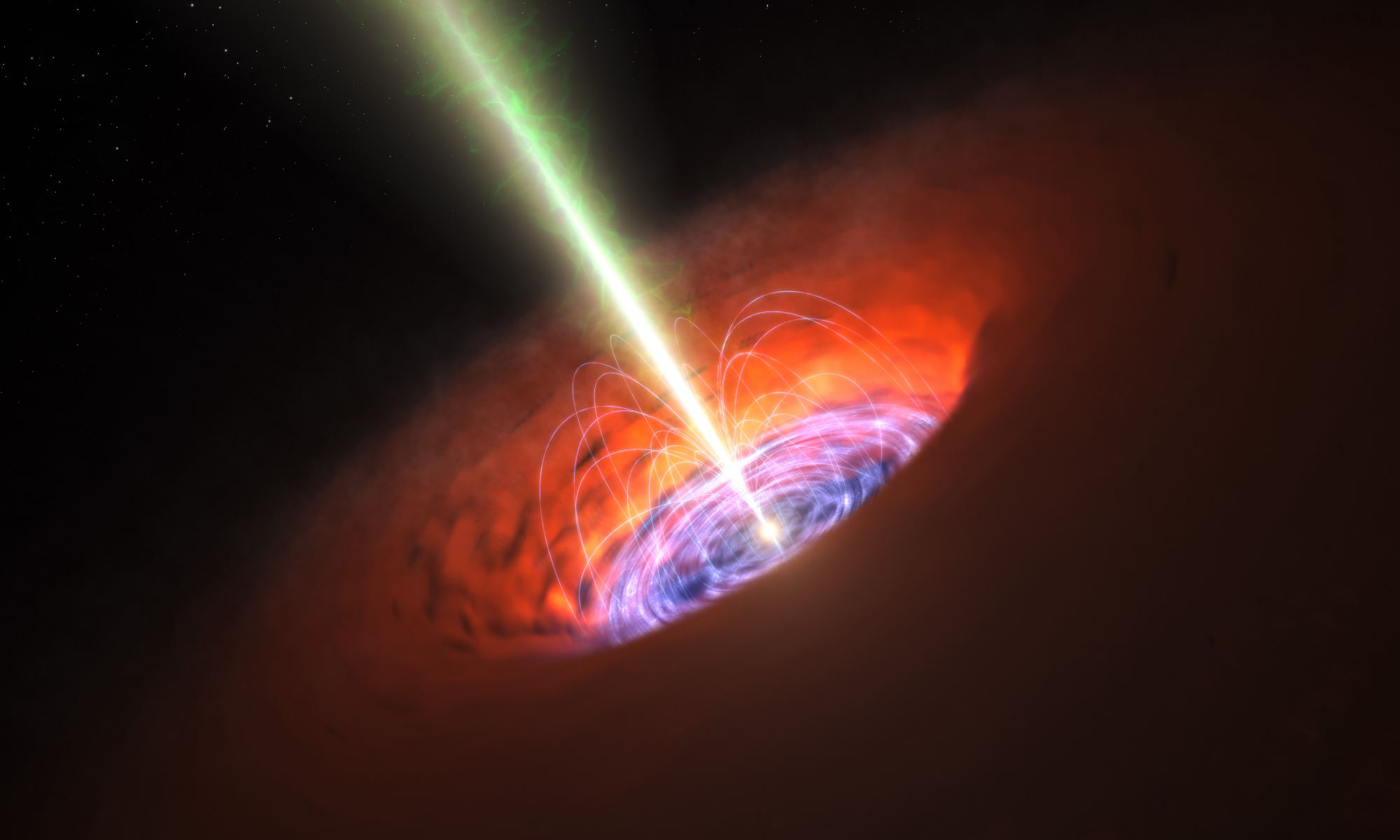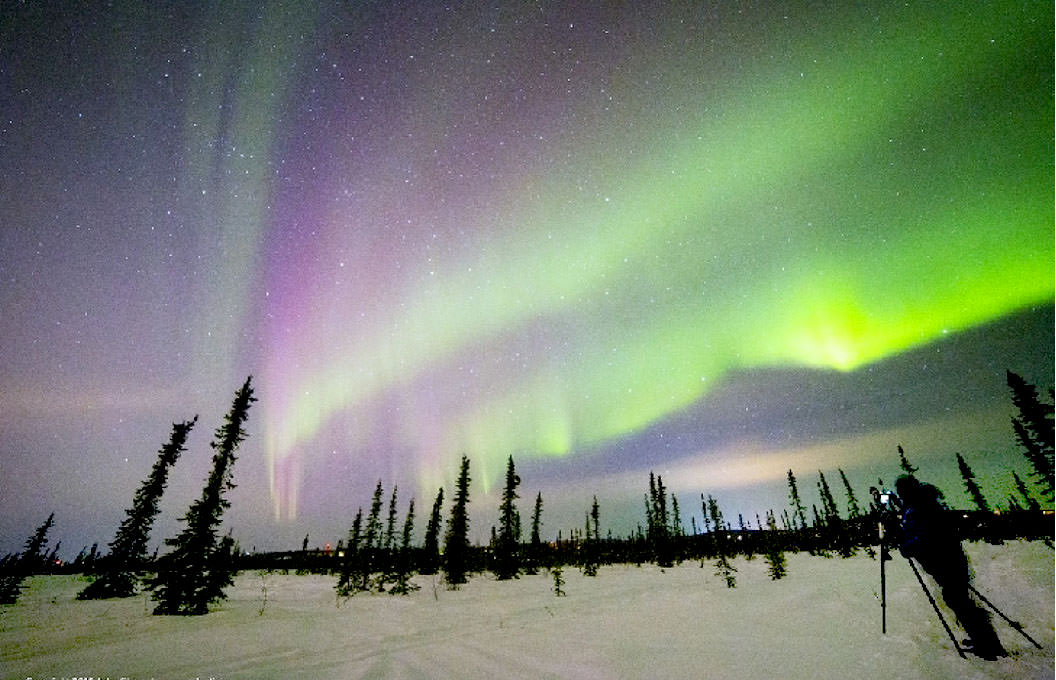Astronomers examining a star cluster near Sgr A*, the Milky Way’s supermassive black hole, found that the cluster has some unusually young members for its location. That’s difficult to explain since the region so close to the powerful black hole is infused with powerful radiation and dominated by the black hole’s extremely powerful gravitational force. According to our understanding of stellar formation, young stars shouldn’t be there.
Continue reading “New Stars Forming Uncomfortably Close to the Milky Way’s Supermassive Black Hole”Rosetta Flew Through the Bow Shock of Comet 67P Several Times During its Mission

In 2014 , the European Space Agency’s (ESA) Rosetta spacecraft made history when it rendezvoused with Comet 67P/Churyumov-Gerasimenko. This mission would be the first of its kind, where a spacecraft intercepted a comet, followed it as it orbited the Sun, and deployed a lander to its surface. For the next two years, the orbiter would study this comet in the hopes of revealing things about the history of the Solar System.
In this time, Rosetta’s science team also directed the orbiter to look for signs of the comet’s bow shock – the boundary that forms around objects as a result of interaction with solar wind. Contrary to what they thought, a recent study has revealed that Rosetta managed to detect signs of a bow shock around the comet in its early stages. This constitutes the first time in history that the formation of a bow shock has been witnessed in our Solar System. Continue reading “Rosetta Flew Through the Bow Shock of Comet 67P Several Times During its Mission”
How Can You see the Northern Lights?
The Northern Lights have fascinated human beings for millennia. In fact, their existence has informed the mythology of many cultures, including the Inuit, Northern Cree, and ancient Norse. They were also a source of intense fascination for the ancient Greeks and Romans, and were seen as a sign from God by medieval Europeans.
Thanks to the birth of modern astronomy, we now know what causes both the Aurora Borealis and its southern sibling – Aurora Australis. Nevertheless, they remain the subject of intense fascination, scientific research, and are a major tourist draw. For those who live north of 60° latitude, this fantastic light show is also a regular occurrence.
Causes:
Aurora Borealis (and Australis) is caused by interactions between energetic particles from the Sun and the Earth’s magnetic field. The invisible field lines of Earth’s magnetoshere travel from the Earth’s northern magnetic pole to its southern magnetic pole. When charged particles reach the magnetic field, they are deflected, creating a “bow shock” (so-named because of its apparent shape) around Earth.
However, Earth’s magnetic field is weaker at the poles, and some particles are therefore able to enter the Earth’s atmosphere and collide with gas particles in these regions. These collisions emit light that we perceive as wavy and dancing, and are generally a pale, yellowish-green in color.
The variations in color are due to the type of gas particles that are colliding. The common yellowish-green is produced by oxygen molecules located about 100 km (60 miles) above the Earth, whereas high-altitude oxygen – at heights of up to 320 km (200 miles) – produce all-red auroras. Meanwhile, interactions between charged particles and nitrogen will produces blue or purplish-red auroras.
Variability:
The visibility of the northern (and southern) lights depends on a lot of factors, much like any other type of meteorological activity. Though they are generally visible in the far northern and southern regions of the globe, there have been instances in the past where the lights were visible as close to the equator as Mexico.
In places like Alaska, Norther Canada, Norway and Siberia, the northern lights are often seen every night of the week in the winter. Though they occur year-round, they are only visible when it is rather dark out. Hence why they are more discernible during the months where the nights are longer.
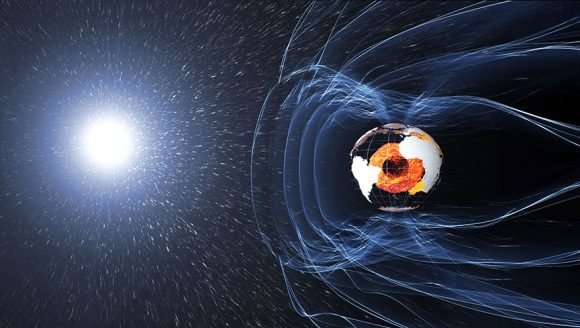
Because they depend on the solar wind, auroras are more plentiful during peak periods of activity in the Solar Cycle. This cycle takes places every 11 years, and is marked by the increase and decrease of sunspots on the sun’s surface. The greatest number of sunspots in any given solar cycle is designated as a “Solar Maximum“, whereas the lowest number is a “Solar Minimum.”
A Solar Maximum also accords with bright regions appearing in the Sun’s corona, which are rooted in the lower sunspots. Scientists track these active regions since they are often the origin of eruptions on the Sun, such as solar flares or coronal mass ejections.
The most recent solar minimum occurred in 2008. As of January 2010, the Sun’s surface began to increase in activity, which began with the release of a lower-intensity M-class flare. The Sun continued to get more active, culminating in a Solar Maximum by the summer of 2013.
Locations for Viewing:
The ideal places to view the Northern Lights are naturally located in geographical regions north of 60° latitude. These include northern Canada, Greenland, Iceland, Scandinavia, Alaska, and Northern Russia. Many organizations maintain websites dedicated to tracking optimal viewing conditions.
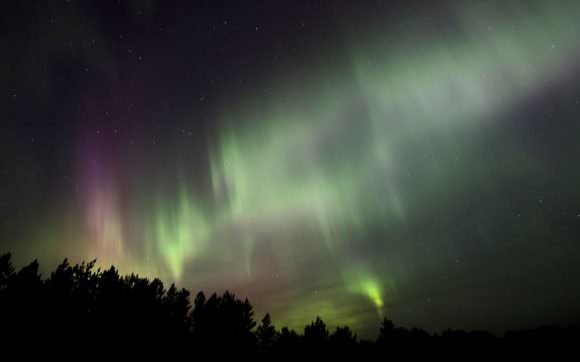
For instance, the Geophysical Institute of the University of Alaska Fairbanks maintains the Aurora Forecast. This site is regularly updated to let residents know when auroral activity is high, and how far south it will extend. Typically, residents who live in central or northern Alaska (from Fairbanks to Barrow) have a better chance than those living in the south (Anchorage to Juneau).
In Northern Canada, auroras are often spotted from the Yukon, the Northwest Territories, Nunavut, and Northern Quebec. However, they are sometimes seen from locations like Dawson Creek, BC; Fort McMurry, Alberta; northern Saskatchewan and the town of Moose Factory by James Bay, Ontario. For information, check out Canadian Geographic Magazine’s “Northern Lights Across Canada“.
The National Oceanic and Atmospheric Agency also provides 30 minute forecasts on auroras through their Space Weather Prediction Center. And then there’s Aurora Alert, an Android App that allows you to get regular updates on when and where an aurora will be visible in your region.
Understanding the scientific cause of auroras has not made them any less awe-inspiring or wondrous. Every year, countless people venture to locations where they can be seen. And for those serving aboard the ISS, they got the best seat in the house!
Speaking of which, be sure to check out this stunning NASA video which shows the Northern Lights being viewed from the ISS:
We have written many interesting articles about Auroras here at Universe Today. Here’s The Northern and Southern Lights – What is an Aurora?, What is the Aurora Borealis?, What is the Aurora Australis?, What Causes the Northern Lights?, How Does the Aurora Borealis Form?, and Watch Fast and Furious All-sky Aurora Filmed in Real Time.
For more information, visit the THEMIS website – a NASA mission that is currently studying space weather in great detail. The Space Weather Center has information on the solar wind and how it causes aurorae.
Astronomy Cast also has episodes on the subject, like Episode 42: Magnetism Everywhere.
Sources:
The Juno Mission
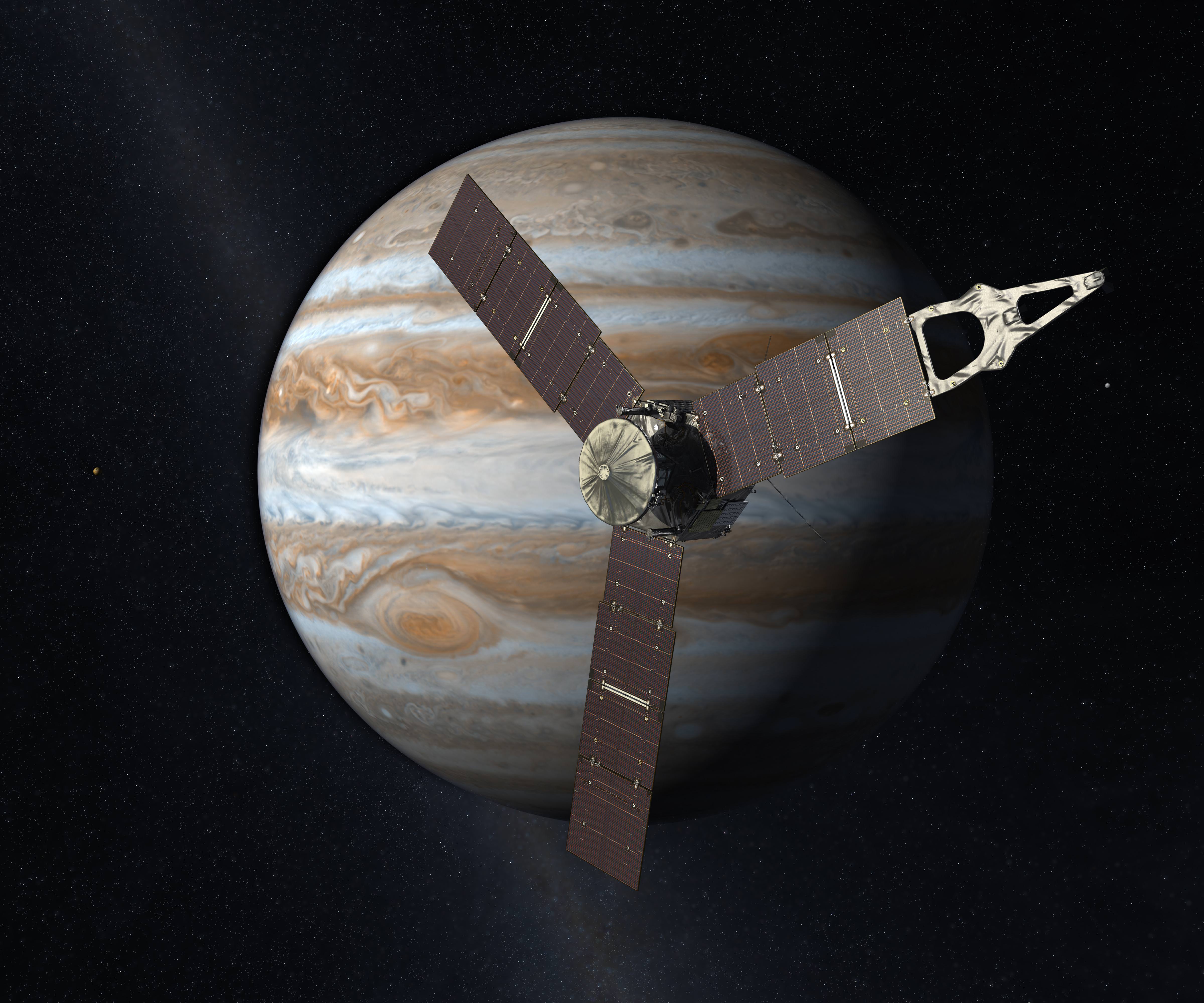
Ever since Galileo first observed it through a telescope in 1610, Jupiter and its system of moons have fascinated humanity. And while many spacecraft have visited the system in the past forty years, the majority of these missions were flybys. With the exception of the Galileo space probe, the visits of these spacecraft to the Jupiter system were one of several intended objectives, taking place before they made their way deeper into the Solar System.
Having launched on August 5th, 2011, NASA’s Juno spacecraft has a different purpose in mind. Using a suite of scientific instruments, Juno will study Jupiter’s atmosphere, magnetic environment, weather patterns, and shed light on the history of its formation. In essence, it will be the first probe since the Galileo mission to orbit Jupiter, where it will spend the next two years sending information about the gas giant back to Earth.
If successful, Juno will prove to be the only other long-term mission to Jupiter. However, compared to Galileo – which spent seven years in orbit around the gas giant – Juno’s mission is planned to last for just two years. However, its improved suite of instruments are expected to provide a wealth of information in that time. And barring any mission extensions, its targeted impact on the surface of Jupiter will take place in February of 2018.
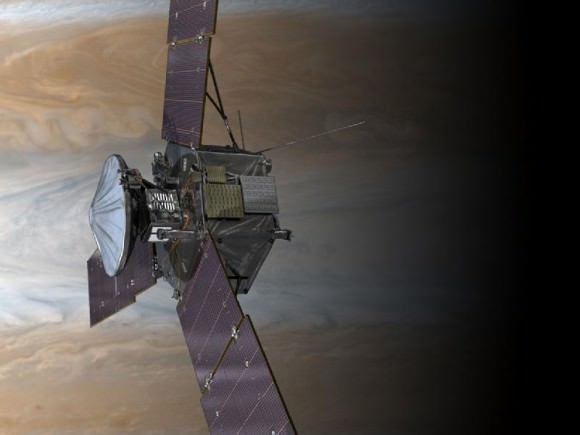
Background:
As part of the NASA’s New Frontiers program, the Juno mission is one of several medium-sized missions intended to explore the various bodies of the Solar System. It is currently one of three probes that NASA is operating, or in the process of building. The other two are the New Horizons probe (which flew by Pluto in 2015) and OSIRIS-REx, which is expected to fly to asteroid 101955 Bennu in 2020 and bring samples back to Earth.
During a 2003 decadal survey – titled “New Frontiers in the Solar System: An Integrated Exploration Strategy” – The National Research Council discussed destinations that would serve as the source for the first competition for the New Frontiers program. A Jupiter orbiter was identified as a scientific priority, which it was hoped would address several unanswered questions pertaining to the gas giant.
These included whether or not Jupiter had a central core (the research of which would help establish how the planet was formed), the water content of Jupiter’s atmosphere, how its weather systems can remain stable, and what the nature of the magnetic field and plasma surrounding Jupiter are. In 2005, Juno was selected for the New Frontiers program alongside New Horizons and OSIRIS-REx.
Though it was originally intended to launch in 2009, NASA budget restrictions forced a delay until August of 2011. The probe was named in honor of the Roman goddess Juno, the wife of Jupiter (the Roman equivalent of Zeus) who was able to peer through a veil of clouds that Jupiter drew around himself. The name was previously a backronym which stood for JUpiter Near-polar Orbiter as well.
Mission Profile:
The Juno mission was created for the specific purpose of studying Jupiter for the sake of learning more about the formation of the Solar System. For some time, astronomers have understood that Jupiter played an important role in the development Solar System. Like the other gas giants, it was assembled during the early stages, before our Sun had the chance to absorb or blow away the light gases in the huge cloud from which they were born.
As such, Jupiter’s composition could tell us much about the early Solar System. Similarly, the gas giants are believed to have played a major role in the process of planet formation because their huge masses allowed them to shape the orbits of other objects – planets, asteroids and comets – in their planetary systems.
However, for astronomers and planetary scientists, much still remains unknown about this massive gas giant. For instance, Jupiter’s interior structure and composition, as well as what drives its magnetic field, are still the subject of theory. Because Jupiter formed at the same time as the Sun, their chemical compositions should be similar, but research has shown that Jupiter has more heavy elements than our Sun (such as carbon and nitrogen).
In addition, there are some unanswered questions about when and where the planet formed. While it may have formed in its current orbit, some evidence suggests that it could have formed farther from the sun before migrating inward. All of these questions, it is hoped, are things the Juno mission will answer.
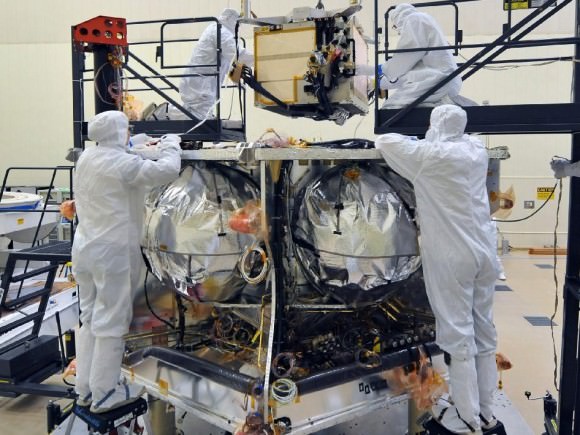
Having launched on August 5th, 2011, the Juno spacecraft spent the next five years in space, and will reach Jupiter on July 4th, 2018. Once in orbit, it will spend the next two years orbiting the planet a total of 37 times from pole to pole, using its scientific instruments to probe beneath the gas giant’s obscuring cloud cover.
Instrumentation:
The Juno spacecraft comes equipped with a scientific suite of 8 instruments that will allow it to study Jupiter’s atmosphere, magnetic and gravitational field, weather patterns, its internal structure, and its formational history. They include:
- Gravity Science: Using radio waves and measuring them for Doppler effect, this instrument will measure the distribution of mass inside Jupiter to create a gravity map. Small variations in gravity along the orbital path of the probe will induce small changes in velocity. The principle investigators of this instrument are John Anderson of NASA’s Jet Propulsion Laboratory and Luciano Iess of the Sapienza University of Rome.
- JunoCam: This visible light/telescope is the spacecraft’s only imaging device. Intended for public outreach and education, it will provide breathtaking pictures of Jupiter and the Solar System, but will operate for only seven orbits around Jupiter (due to the effect Jupiter’s radiation and magnetic field have on instruments). The PI for this instrument is Michael C. Malin, of Malin Space Science Systems
- Jovian Auroral Distribution Experiment (JADE): Using three energetic particle detectors, the JADE instrument will measure the angular distribution, energy, and velocity vector of low energy ions and electrons in the auroras of Jupiter. The PI is David McComas of the Southwest Research Institute (SwRI).
- Jovian Energetic Particle Detector Instrument (JEDI): Like JADE, JEDI will measure the angular distribution and the velocity vector of ions and electrons, but at high-energy and in the magnetosphere of Jupiter. The PI is Barry Mauk of NASA’s Applied Physics Laboratory.
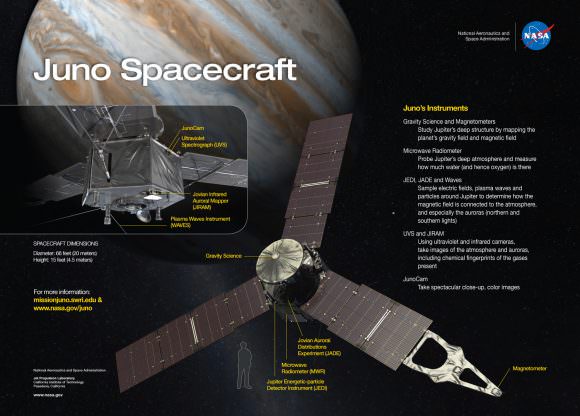
- Jovian Infrared Aural Mapper (JIRAM): Operating in the near-infrared, this spectrometer will be responsible for mapping the upper layers of Jupiter’s atmosphere. By measuring the heat that is radiated outward, it will determine how water-rich clouds can float beneath the surface. It will also be able to assess the distribution of methane, water vapor, ammonia and phosphine in Jupiter’s atmosphere. Angioletta Coradini of the Italian National Institute for Astrophysics is the PI on this instrument.
- Magnetometer: This instrument will be used to map Jupiter’s magnetic field, determine the dynamics of the planet’s interior and determine the three-dimensional structure of the polar magnetosphere. Jack Connemey of NASA’s Goddard Space Flight Center is the instrument’s PI.
- Microwave Radiometer: The MR instrument will perform measurements of the electromagnetic waves that pass through the Jovian atmosphere, measuring the abundance of water and ammonia in its deep layers. In so doing, it will obtain a temperature profile at various levels and determine how deep the atmospheric circulation of Jupiter is. The PI for this instrument is Mike Janssen of the JPL.
- Radio and Plasma Wave Sensor (RPWS): This RPWS will measure the radio and plasma spectra in Jupiter’s auroral region. In the process, it will identify the regions of auroral currents that define the planet’s radio emissions and accelerate its auroral particles. William Kurth of the University of Iowa is the PI.
- Ultraviolet Imaging Spectrograph (UVS): The UVS will record the wavelength, position and arrival time of detected ultraviolet photons, providing spectral images of the UV auroral emissions in the polar magnetosphere. G. Randall Gladstone of the SwRI is the PI.
In addition to its scientific suite, the Juno spacecraft also carries a commemorative plaque dedicated to Galileo Galilei. The plaque was provided by the Italian Space Agency and depicts a portrait of Galileo, as well as script that had been composed by Galileo himself on the occasion that he observed Jupiter’s four largest moons (known today as the Galilean Moons).
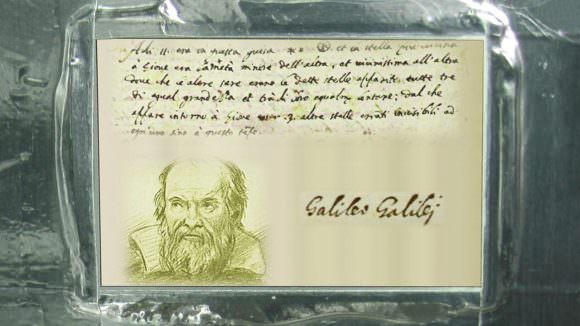
The text, written in Italian and transcribed from Galileo’s own handwriting, translates as:
“On the 11th it was in this formation, and the star closest to Jupiter was half the size than the other and very close to the other so that during the previous nights all of the three observed stars looked of the same dimension and among them equally afar; so that it is evident that around Jupiter there are three moving stars invisible till this time to everyone.”
The spacecraft also carries three Lego figurines representing Galileo, the Roman god Jupiter and his wife Juno. The figure of Juno holds a magnifying glass as a sign of her searching for the truth, Jupiter holds a lightning bolt, and the figure of Galileo Galilei holds his famous telescope. Lego made these figurines out of aluminum (instead of the usual plastic) to ensure they would survive the extreme conditions of space flight.
Launch:
The Juno mission launched from Cape Canaveral Air Force Station on August 5th, 2011, atop an Atlas V rocket. After approximately 1 minute and 33 seconds, the five Solid Rocket Boosters (SRBs) reached burnout and then fell away. After 4 minutes and 26 seconds after liftoff, the Atlas V main engine cut off, followed 16 seconds later by the separation of the Centaur upper stage rocket.
After a burn that lasted for 6 minutes, the Centaur was put into its initial parking orbit. It coasted for approximately 30 minutes before its engine conducted a second firing which lasted for 9 minutes, putting the spacecraft on an Earth escape trajectory. About 54 minutes after launch, the spacecraft separated from the Centaur and began to extend its solar panels.
A year after launch, between August and September 2012, the Juno spacecraft successfully conducted two Deep Space Maneuvers designed to correct its trajectory. The first maneuver (DSM-1) occurred on August 30th, 2012, with the main engine firing for approximately 30 minutes and altering its velocity by about 388 m/s (1396.8 km/h; 867 mph).
The second maneuver (DSM-2), which had a similar duration and resulted in a similar velocity change, took place on September 14th. The two firings occurred when the probe was about 480 million km (298 million miles) from Earth, and altered the spacecraft’s speed and its Jupiter-bound trajectory, setting the stage for a gravity assist from its flyby of Earth.
Earth Flyby:
Juno’s Earth flyby took place on October 9th, 2013, after the spacecraft completed one elliptical orbit around the Sun. During its closest approach, the probe was at an altitude of about 560 kilometers (348 miles). The Earth flyby boosted Juno’s velocity by 3,900 m/s (14162 km/h; 8,800 mph) and placed the spacecraft on its final flight path for Jupiter.
During the flyby, Juno’s Magnetic Field Investigation (MAG) instrument managed to capture some low-resolution images of the Earth and Moon. These images were taken while the Juno probe was about 966,000 km (600,000 mi) away from Earth – about three times the Earth-moon separation. They were later combined by technicians at NASA’s JPL to create the video shown above.
The Earth flyby was also used as a rehearsal by the Juno science team to test some of the spacecraft’s instruments and to practice certain procedures that will be used once the probe arrives at Jupiter.
Rendezvous With Jupiter:
The Juno spacecraft reached the Jupiter system and established polar orbit around the gas giant on July 4th, 2016. It’s orbit will be highly elliptical and will take it close to the poles – within 4,300 km (2,672 mi) – before reaching beyond the orbit of Callisto, the most distant of Jupiter’s large moons (at an average distance of 1,882,700 km or 1,169,855.5 mi).
This orbit will allow the spacecraft to avoid long-term contact with Jupiter’s radiation belts, while still allowing it to perform close-up surveys of Jupiter’s polar atmosphere, magnetosphere and gravitational field. The spacecraft will spend the next two years orbiting Jupiter a total of 37 times, with each orbit taking 14 days.
Already, the probe has performed measurements of Jupiter’s magnetic field. This began on June 24th when Juno crossed the bow shock just outside Jupiter’s magnetosphere, followed by it’s transit into the lower density of the Jovian magnetosphere on June 25. Having made the transition from an environment characterized by solar wind to one dominated by Jupiter’s magnetosphere, the ship’s instruments revealed some interesting information about the sudden change in particle density.
The probe entered its polar elliptical orbit on July 4th after completing a 35-minute-long firing of the main engine, known as Jupiter Orbital Insertion (or JOI). As the probe approached Jupiter from above its north pole, it was afforded a view of the Jovian system, which it took a final picture of before commencing JOI.
On July 10th, the Juno probe transmitted its first imagery from orbit after powering back up its suite of scientific instruments. The images were taken when the spacecraft was 4.3 million km (2.7 million mi) from Jupiter and on the outbound leg of its initial 53.5-day capture orbit. The color image shows atmospheric features on Jupiter, including the famous Great Red Spot, and three of the massive planet’s four largest moons – Io, Europa and Ganymede, from left to right in the image.
While the mission team had hoped to reduce Juno’s orbital period to 14 days, thus allowing for it to conduct a total of 37 perijoves before mission’s end. However, due to a malfunction with the probe’s helium valves, the firing was delayed. NASA has since announced that it will not conduct this engine firing, and that the probe will conduct a total perijoves in total before the end of its mission.
End of Mission:
The Juno mission is set to conclude in February of 2018, after completing 12 orbits of Jupiter. At this point, and barring any mission extensions, the probe will be de-orbited to burn up in Jupiter’s outer atmosphere. As with the Galileo spacecraft, this is meant be to avoid any possibility of impact and biological contamination with one of Jupiter’s moons.
The mission is managed by the JPL, and its principal investigator is Scott Bolton of the Southwest Research Institute. NASA’s Launch Services Program, located at the Kennedy Space Center in Florida, is responsible for managing launch services for the probe. The Juno mission is part of the New Frontiers Program managed by NASA’s Marshall Space Flight Center in Huntsville, Ala.
As of the writing of this article, the Juno mission is one day, four hours and fifty-five minutes away from its historic arrival with Jupiter. Check out NASA’s Juno mission page to get up-to-date information on the mission, and stay tuned to Universe Today for updates!
We have written many interesting articles about Jupiter here at Universe today. Here’s Juno Blasts off on Science Trek to Discover Jupiter’s Genesis, Jupiter Bound Juno snaps Dazzling Gallery of Planet Earth Portraits, Understanding Juno’s Orbit: An Interview with NASA’s Scott Bolton, NASA’s Juno probe Gets Gravity Speed Boost during Earth Flyby But Enters ‘Safe Mode.
Astronomy cast also has relevant episodes on the subject. Here’s Episode 59: Jupiter, and Episode 232: Galileo Spacecraft,
For more information, check out NASA’s Juno mission page, and the Southwest Research Institute’s Juno page.
Runaway Star Shocks the Galaxy!

That might seem like a sensational headline worthy of a supermarket tabloid but, taken in context, it’s exactly what’s happening here!
The bright blue star at the center of this image is a B-type supergiant named Kappa Cassiopeiae, 4,000 light-years away. As stars in our galaxy go it’s pretty big — over 57 million kilometers wide, about 41 times the radius of the Sun. But its size isn’t what makes K Cas stand out — it’s the infrared-bright bow shock it’s creating as it speeds past its stellar neighbors at a breakneck 1,100 kilometers per second.
K Cas is what’s called a runway star. It’s traveling very fast in relation to the stars around it, possibly due to the supernova explosion of a previous nearby stellar neighbor or companion, or perhaps kicked into high gear during a close encounter with a massive object like a black hole.
As it speeds through the galaxy it creates a curved bow shock in front of it, like water rising up in front of the bow of a ship. This is the ionized glow of interstellar material compressed and heated by K Cas’ stellar wind. Although it looks like it surrounds the star pretty closely in the image above, the glowing shockwave is actually about 4 light-years out from K Cas… slightly less than the distance from the Sun to Proxima Centauri.
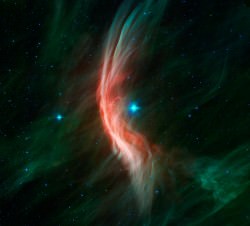
Although K Cas is visible to the naked eye, its bow shock isn’t. It’s only made apparent in infrared wavelengths, which NASA’s Spitzer Space Telescope is specifically designed to detect. Some other runaway stars have brighter bow shocks — like Zeta Ophiuchi at right — which can be seen in optical wavelengths (as long as they’re not obscured by dust, which Zeta Oph is.)
Related: Surprise! IBEX Finds No Bow ‘Shock’ Outside our Solar System
The bright wisps seen crossing K Cas’ bow shock may be magnetic filaments that run throughout the galaxy, made visible through interaction with the ionized gas. In fact bow shocks are of particular interest to astronomers precisely because they help reveal otherwise invisible features and allow deeper investigation into the chemical composition of stars and the regions of the galaxy they are traveling through. Like a speeding car on a dark country road, runaway stars’ bow shocks are — to scientists — like high-beam headlamps lighting up the space ahead.
Runaway stars are not to be confused with rogue stars, which, although also feel the need for speed, have been flung completely out of their home galaxies.
Source: NASA
Surprise! IBEX Finds No Bow ‘Shock’ Outside our Solar System
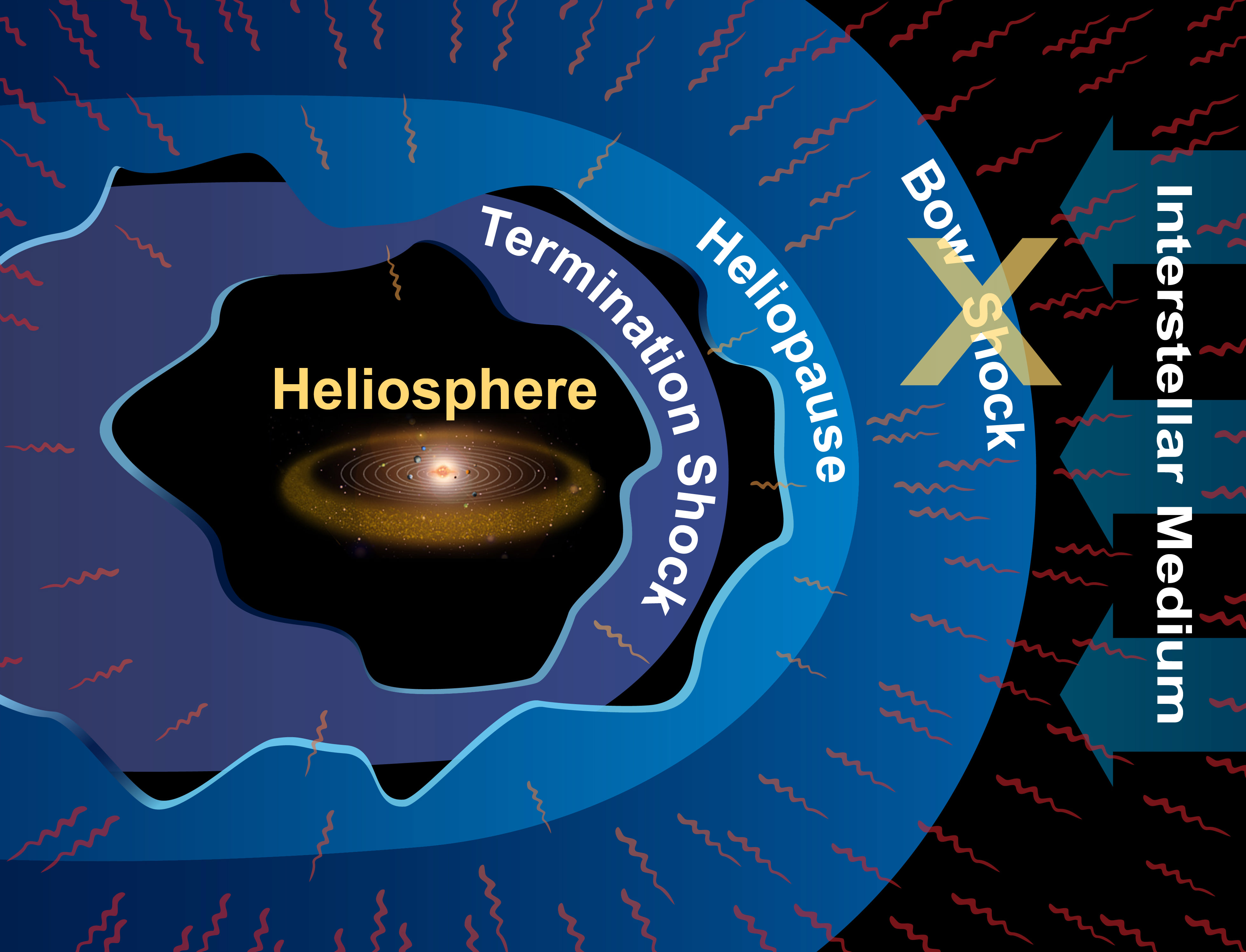
[/caption]
For years, scientists have thought a bow “shock” formed ahead of our solar system’s heliosphere as it moved through interstellar space – similar to the sonic boom made by a jet breaking the sound barrier. But new data from NASA’s Interstellar Boundary Explorer (IBEX) shows that our system and its heliosphere move through space too slowly to form a bow shock, and therefore does not exist. Instead there is a more gentle ‘wave.’
“While bow shocks certainly exist ahead of many other stars, we’re finding that our Sun’s interaction doesn’t reach the critical threshold to form a shock,” said Dr. David McComas, principal investigator of the IBEX mission, “so a wave is a more accurate depiction of what’s happening ahead of our heliosphere — much like the wave made by the bow of a boat as it glides through the water.”
From IBEX data, McComas and his team were able to make refinements in relative speed of our system, as well as finding more information about the local interstellar magnetic field strength. IBEX data have shown that the heliosphere actually moves through the local interstellar cloud at about 52,000 miles per hour, roughly 7,000 miles per hour slower than previously thought. That is slow enough to create more of a bow “wave” than a shock.

Another influence is the magnetic pressure in the interstellar medium. IBEX data, as well as earlier Voyager observations, show that the magnetic field is stronger in the interstellar medium requiring even faster speeds to produce a bow shock. Combined, both factors now point to the conclusion that a bow shock is highly unlikely.
This new finding perhaps correlates with earlier investigations by the CLUSTER mission, which found the bow shock was remarkably thin.
The IBEX team combined its data with analytical calculations and modeling and simulations to determine the conditions necessary for creating a bow shock. Two independent global models — one from a group in Huntsville, Ala., and another from Moscow — correlated with the analytical findings.
Their paper was published today in the journal Science.
How does this new finding change our understanding of our heliosphere?
“It’s too early to say exactly what this new data means for our heliosphere,” McComas said. “Decades of research have explored scenarios that included a bow shock. That research now has to be redone using the latest data. Already, we know there are likely implications for how galactic cosmic rays propagate around and enter the solar system, which is relevant for human space travel.”
Source: SwRI

